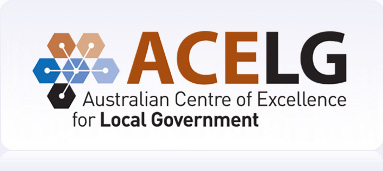Innovation in Australian Local Government

ACELG has recently released a significant paper prepared by Dr John Howard called `Innovation, Ingenuity and Initiative: The Adoption and Application of New Ideas in Australian Local Government`. In the paper, Dr Howard has identified areas where local government has embraced the adoption and application of new ideas and where it has sought to transform the way the business of local government is undertaken.
The research acknowledges the current environment where local government is budget constrained, resource poor, and operating environments are tightly controlled. Currently, elected members and managers do not have a body of research and a stockpile of resources to invest in innovation. Rather, innovation in local government has been carried forward by motivated, clever, smart and knowledgeable people. These people are innate problem solvers and are prepared to ‘think outside the square’ and follow a passion for doing something new and different.
The paper points out that there are a lot of people like this in councils right across the spectrum of capacity and available resources. Some are acknowledged in awards and accolades such as the National Local Government Awards. A number of these are profiled in the paper as case studies.
The paper also makes it clear that Australian local government has approached innovation with people using a great deal of initiative and ingenuity in challenging environments, characterised by resource constraints, change, and expectations. Many have adopted and applied new technologies to implement ideas that will improve local government performance.
Over sixty examples from councils across Australia that are putting new ideas into practice are included in the paper, and it concludes with a number of challenges and issues for consideration by the sector.
See also Dr Howard`s presentation to the ACELG Brisbane Research Showcase (link) and the ACELG Innovation and Best Practice program page.
Highlights of Paper
The Potential for Innovation
Innovation in organisations is not a new concept. It is about the successful application of new ideas; it is how businesses survive, grow and sustain themselves – and stay relevant; and it is a capability that needs to be embedded in an organisation`s strategy, structure, systems, and culture.
In local government the potential for innovation cuts across all functions and services including asset management, development control, waste management, sustainability programs, natural resource management, community services, trading enterprises and economic development. Within the sector there have been some significant achievements (a number of these are outlined in an attachment to the paper) but widespread adoption and application of new ideas is uneven.
The Discipline of Innovation
In local government, elected members and staff need to study and learn about what is happening in the local government industry, the changes taking place in industry structure in Australia and around the world and the changing demands and expectations of communities, suppliers, employees and other stakeholders. According to the author the following discipline might be applied to achieve innovation in local government:
- The continual search for new ideas - ideas that can solve a problem or capture an opportunity, external and/or internal (Ingenuity, invention, creativity)
- Testing ideas through pilots and experiments (Initiative, commitment)
- Implementation and adoption through strategies and initiatives (Innovation)
It is stressed that it is people who innovate and drive innovation, working through teams and collaborations. Also, as bureaucracy can stifle innovation, rules, processes and procedures must be carefully crafted.
Where Councils are Achieving Innovation Outcomes
Through a review of a number of award schemes and research discussions, Dr Howard lists the following areas where councils are achieving innovation outcomes:
- The delivery, maintenance and repair of a portfolio of physical assets
- Provision of water, sewerage and drainage facilities and services
- Management of rubbish, waste, and garbage
- Regulation and control of land use through statutory planning and development control tools
- Preservation, restoration and repair of natural capital assets and control over weeds
- Maintenance of public and community health services
- Delivery of a range of community services for target groups (ie childcare, aged and youth)
- Provision of community sports, recreation, arts and cultural facilities and services
- Management of trading enterprises ie aerodromes, quarries, cemeteries etc
- Supporting and facilitating economic development, ie tourist promotion, business attraction and higher education collaborations.
Towards a New Agenda for Local Government Innovation
The following aspects are emphasised in the paper’s concluding remarks to ensure that innovation is embedded in the ongoing development and performance of Australian local government:
- Industry restructure. New roles, responsibilities, resources for local government - not amalgamation.
- Leadership in regional innovation systems. Knowledge clusters, precincts, networks, and with support and involvement of ROCs or alliances of councils based around common themes.
- Partnerships and collaborations. For example, with education and industry. Such arrangements are seen by industry and policy makers as critical for innovation.
- Outsourcing and commissioning. Not new by any means but impacts have included the reduction of costs as well as innovation in the way services are provided. Underpinned by the ‘steering rather than rowing’ paradigm (Osborne and Gaebler, and others).
- Adoption and application of technology. The advent of ‘digital councils’. The current technology environment is only limited by the ingenuity and initiative of managers, front line service personnel and users.
- Social media. Its adoption and use, including mobile technologies. This is detailed in other ACELG research Connecting with Communities: How Local Government is Using Social Media to Engage with Citizens (ACELG 2012) and the related 2011 Survey Report.
- Open innovation, innovation sourcing, and competitions.
- Innovation Action Plans. A number of aspects are suggested drawing upon the Commonwealth’s APS Innovation Action Plan (2011) such as Developing an innovation consciousness; Building innovation capacity; Leveraging the power of co-creation; Strengthening leadership so there is the courage to innovate at all levels.
See also Dr Howard`s presentation to the ACELG Brisbane Research Showcase (link) and the ACELG Innovation and Best Practice program page.



